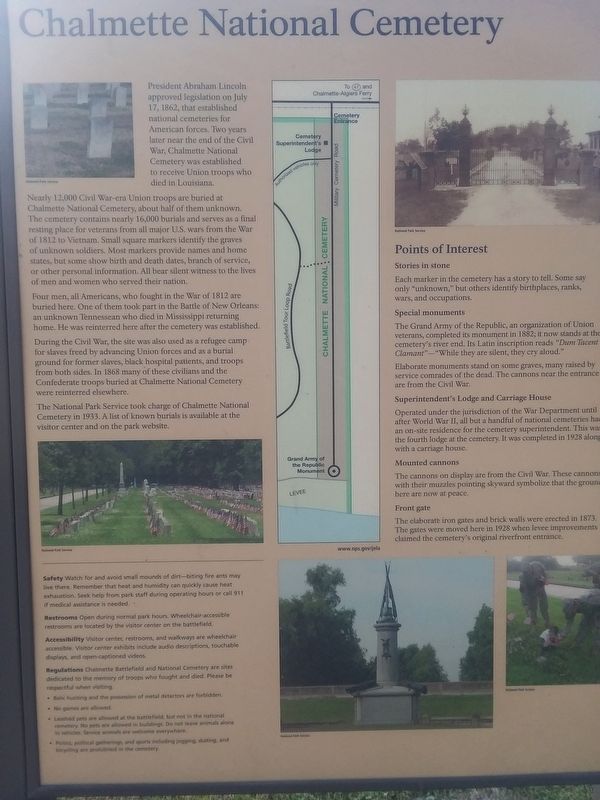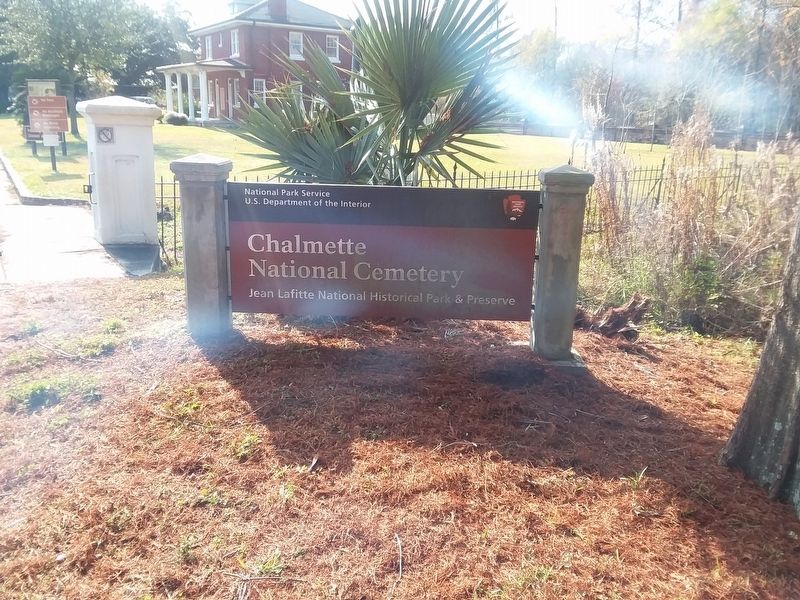Chalmette in St. Bernard Parish, Louisiana — The American South (West South Central)
Chalmette National Cemetery
Nearly 12,000 Civil War-era Union troops are buried at Chalmette National Cemetery, about half of them unknown. The cemetery contains nearly 16,000 burials and serves as a final resting place for veterans from all major U.S. wars from the War of 1812 to Vietnam. Small square markers identify the graves of unknown soldiers. Most markers provide names and home states, but some show birth and death dates, branch of service, or other personal information. All bear silent witness to the lives of men and women who served their nation.
Four men, all Americans, who fought in the War of 1812 are buried here. One of them took part in the Battle of New Orleans: an unknown Tennessean who died in Mississippi returning home. He was reinterred here after the cemetery was established.
During the Civil War, the site was also used as a refugee camp for slaves freed by advancing Union forces and as a burial ground for former slaves, black hospital patients, and troops from both sides. In 1868 many of these civilians and the Confederate troops buried at Chalmette National Cemetery were reinterred elsewhere.
The National Park Service took charge of Chalmette National Cemetery in 1933. A list of known burials is available at the visitor center and on the park website.
Safety Watch for and avoid small mounds of dirt-biting fire ants may live there. Remember that heat and humidity can quickly cause heat exhaustion. Seek help from park staff during operating hours or call 911 if medical assistance is needed. Restrooms Open during normal park hours. Wheelchair-accessible restrooms are located by the visitor center on the battlefield. Accessibility Visitor center, restrooms, and walkways are wheelchair accessible. Visitor center exhibits include audio descriptions, touchable displays, and open-captioned videos. Regulations Chalmette Battlefield and National Cemetery are sites dedicated to the memory of troops who fought and died. Please be respectful when visiting. • Relic hunting and the possession of metal detectors are forbidden. • No games are allowed. • Leashed pets are allowed at the battlefield, but not in the national cemetery. No pets are allowed in buildings. Do not leave animals alone in vehicles. Service animals are welcome everywhere. • Picnics, political gatherings, and sports including jogging, skating, and bicycling are prohibited in the cemetery.
Points of Interest
Stories in stone
Each marker in the cemetery has a story to tell. Some say only "unknown,” but others identify birthplaces, ranks, wars, and occupations.
Special monuments
The Grand Army of the Republic, an organization of Union veterans, completed its monument in 1882; it now stands at the cemetery's river end. Its Latin inscription reads "Dum Tacent Clamant"-"While they are silent, they cry aloud."
Elaborate monuments stand on some graves, many raised by service comrades of the dead. The cannons near the entrance are from the Civil War.
Superintendent's Lodge and Carriage House
Operated under the jurisdiction of the War Department until after World War II, all but a handful of national cemeteries had an on-site residence for the cemetery superintendent. This was the fourth lodge at the cemetery. It was completed in 1928 along with a carriage house.
Mounted cannons
The cannons on display are from the Civil War. These cannons W with their muzzles pointing skyward symbolize that the ground here are now at peace.
Front gate
The elaborate iron gates and brick walls were erected in 1873. The gates were moved here in 1928 when levee improvements claimed the cemetery's original riverfront entrance.
Topics. This historical marker is listed in these topic lists: Cemeteries & Burial Sites • Military. A significant historical date for this entry is July 17, 1862.
Location. 29° 56.66′ N, 89° 59.191′ W. Marker is in Chalmette, Louisiana, in St. Bernard Parish. Marker is on Chalmette National Cemetery Road south of West St Bernard Highway (State Route 46), on the right when traveling south. Touch for map. Marker is in this post office area: Chalmette LA 70043, United States of America. Touch for directions.
Other nearby markers. At least 8 other markers are within walking distance of this marker. Serving Those Who Saved Us (within shouting distance of this marker); Chalmette Plantation (within shouting distance of this marker); Here We Honor Veterans Who Served Their Country (about 500 feet away, measured in a direct line); Pakenham's Fall (approx. 0.2 miles away); The Main Attack (approx. 0.2 miles away); a different marker also named Chalmette National Cemetery (approx. 0.2 miles away); Roads and Ditches (approx. 0.2 miles away); The Kentucky Rifle (approx. 0.3 miles away). Touch for a list and map of all markers in Chalmette.
Credits. This page was last revised on January 30, 2022. It was originally submitted on January 29, 2022, by Craig Doda of Napoleon, Ohio. This page has been viewed 136 times since then and 29 times this year. Photos: 1, 2. submitted on January 29, 2022, by Craig Doda of Napoleon, Ohio. • Mark Hilton was the editor who published this page.

